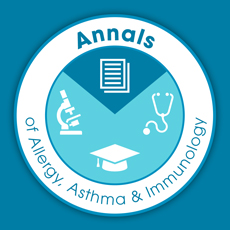 As we move into the swelter of summer, I hope you have had opportunity to look at your June issue of the Annals of Allergy, Asthma and Immunology. There are many features that should hold your interest and provide information to improve the care of your patients. Our theme of the month is Drug Allergy and Delabeling. A review article written by a team led by Elizabeth Phillips, MD from Nashville describes the public health impact and safety of delabeling of children who have been reported to have penicillin (PCN) allergy. The authors report that PCN allergy testing is a safe and effective way to delabel those with reported allergy. In children with low-risk allergy symptoms, a direct oral challenge approach may be the optimal approach. In those children with history of high-risk allergy symptoms, a 3-tiered approach is most ideal. There is a significant cost associated with reported PCN allergy and increased negative health benefits to those children with reported allergy. The authors conclude PCN allergy is overdiagnosed, often incorrect, and the label is frequently first applied during childhood. Targeting children for PCN allergy label removal provides a mechanism to reduce use of broader spectrum and less effective antibiotics.
As we move into the swelter of summer, I hope you have had opportunity to look at your June issue of the Annals of Allergy, Asthma and Immunology. There are many features that should hold your interest and provide information to improve the care of your patients. Our theme of the month is Drug Allergy and Delabeling. A review article written by a team led by Elizabeth Phillips, MD from Nashville describes the public health impact and safety of delabeling of children who have been reported to have penicillin (PCN) allergy. The authors report that PCN allergy testing is a safe and effective way to delabel those with reported allergy. In children with low-risk allergy symptoms, a direct oral challenge approach may be the optimal approach. In those children with history of high-risk allergy symptoms, a 3-tiered approach is most ideal. There is a significant cost associated with reported PCN allergy and increased negative health benefits to those children with reported allergy. The authors conclude PCN allergy is overdiagnosed, often incorrect, and the label is frequently first applied during childhood. Targeting children for PCN allergy label removal provides a mechanism to reduce use of broader spectrum and less effective antibiotics.
We have also published two outstanding perspectives articles. One perspective by Margee Louisias, MD, MPH and Paige Wickner, MD, MPH from Boston calls for an “all hands on deck” approach to drug delabeling efforts by allergists-immunologists in practical clinical settings. The authors set a goal for all of us to have a culture shift where drug allergies and drug allergy review are paired in importance with medication reconciliation at every office visit, every admission and every procedure, but most importantly, done correctly. Continued efforts in this area have the potential to impact drug allergy delabelling on a large scale. In turn, this will minimize unnecessary avoidance of first-line medications.
A second perspective by Roland Solensky, MD, FACAAI from Corvalis, OR explores how we as clinicians should counsel patients and advocate for strong policy to improve access to penicillin allergy assessment. This includes testing where appropriate to facilitate delabeling of the vast majority of patients inappropriately labeled as penicillin allergic. Since approximately 30 million Americans report a history of penicillin allergy, removal of the inaccurate label of penicillin allergy in about 95% of these individuals has public health implications. Evaluation of penicillin allergy most typically involves penicillin skin testing followed by oral amoxicillin challenge, if the skin test is negative. However, in some clinical scenarios, such as in children with mild reaction histories, there is potential for performing direct oral challenge without prior skin testing. Whatever the approach to delabeling may be, allergists need to continue to publicize the hazards of penicillin allergy not just to other clinicians, but also directly to the public.
We also have published the GRADE recommendations for anaphylaxis management in this month’s issue. GRADE methodology encourages a nuanced relationship between certainty of evidence and strength of recommendations. Strength of recommendation must incorporate key factors including the balance between benefits/harms, patient values/preferences, and resource allocation (costs). Equity, feasibility, and acceptability are also often included as considerations. GRADE guidelines provide recommendations that are characterized by directionality (for or against) and strength (strong or conditional). A conditional recommendation is tailored to context and primarily applied through a lens of patient preferences related to the likelihood of outcomes of importance and a shared decision-making approach. While the 2020 Anaphylaxis GRADE guideline better informs the practice of anaphylaxis prevention through (1) identification and mitigation of risk factors for biphasic anaphylaxis and (2) evaluation of the use of glucocorticoid and/or antihistamine pretreatment, all GRADE recommendations, while directional, are conditional and as such should not be universally applied to every circumstance. I believe you will find this information useful in your practice.
I hope everyone stays safe and healthy this summer as we all work to get back to normal. Take some time for yourself and your friends and loved ones. Do not miss an opportunity to express things most important to you and keeping a positive outlook. As we work through this time together, we will be stronger for it as we emerge on the other side. See you next month.
Gailen D. Marshall, Jr., MD PhD FACAAI
Editor-in-chief